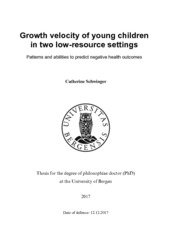| dc.contributor.author | Schwinger, Catherine | en_US |
| dc.date.accessioned | 2018-01-23T10:54:52Z | |
| dc.date.available | 2018-01-23T10:54:52Z | |
| dc.date.issued | 2017-12-12 | |
| dc.identifier.isbn | 978-82-308-3883-9 | en_US |
| dc.identifier.uri | https://hdl.handle.net/1956/17271 | |
| dc.description.abstract | Introduction Measuring child growth repeatedly over time has theoretical advantages over measuring growth at a single time point, such as the early detection of deviations in growth. A timely identification of children at risk could guide effective preventive or therapeutic action. Although the WHO growth velocity standards offers the opportunity to score weight and length velocity according to the rate at which children ought to grow, it is rarely used. This thesis aims to describe growth velocity in children under the age of two years in two low-resource settings, using the WHO Child Growth Standards, and to examine the ability of growth velocity Z-scores to predict short-term mortality and future nutritional status. Methods We used data from children under the age of five years enrolled in two large community-based cohort studies in the Democratic Republic of the Congo (DRC) and Nepal. Both settings represent areas with a high prevalence of malnutrition. The study in the DRC was conducted in Bwamanda, a rural area with the main livelihood of subsistence farming. In total, 5,657 children were enrolled over the study period. Weight, length/height and mid-upper-arm-circumference (MUAC) were measured up to six times on average every three months. The study in Nepal was conducted in the municipality of Bhaktapur, a peri-urban area, where food items are available all-year round, but food prices vary according to the season. All 240 children were enrolled within 17 days after birth, and weight and length were measured every month up to two years of age. All anthropometrical measures were scored according to the WHO Child Growth Standards, and children defined as being malnourished if the Z-score was ≤-2. Attained growth indices considered in this thesis were length-for-age (LAZ), weight-for-length (WLZ), weight-for-age (WAZ), and MUAC-for-age, and longitudinal indices were weight velocity and length velocity. Changes in MUAC were calculated as the difference in cm or Z-score and standardized to an exact 3-month period. Multiple mixed effect models were used to describe if weight or length velocity Z-scores changed according to season and distance to sources of food and health care. We built generalized estimating equation (GEE) models to assess the risk of mortality within three months, separately for indicators of attained and longitudinal growth. To assess the risk of malnutrition at the age of two years, we used simple linear and logistic regression models with growth indicators during infancy as the independent variables. Areas under the ROC curves (AUROC) were the basis for evaluating and comparing the predictive abilities of growth velocity and attained growth to predict death within three months or malnutrition at the age of two years, respectively. Ethical approval was obtained from appropriate institutions and ethical principles were respected. Results Growth velocity Z-scores were low just after birth in the Bwamanda cohort and improved slightly with increasing age. In the Bhaktapur cohort, weight and length velocity Z-scores were above the median of the WHO standards in the first three months of life. After a decrease until the age of 5 and 13 months respectively, Z-scores improved marginally until 24 months. Weight and length velocity Z-scores showed a marked seasonal pattern in the Bwamanda cohort, whereas indices of attained growth decreased continuously over time. Age and season were independently associated with weight and length velocity. Weight and length velocity were better in predicting death within the next three months compared to their attained growth counterparts in the Bwamanda cohort. In contrast, there was no advantage to assess MUAC longitudinally. In the Bhaktapur cohort, attained growth indices at the age of 12 months had better abilities to predict undernutrition at the age of two years than weight and length velocity during periods in infancy. Conclusion Our results show that measures of attained and longitudinal growth used for this thesis capture partly different aspects of child growth. Therefore both approaches are useful to understand and study malnutrition. Currently, the practical use of growth velocity Z-scores has some limitations, but their value for research and for short-term prediction of unfortunate health outcomes should be considered. | en_US |
| dc.language.iso | eng | eng |
| dc.publisher | The University of Bergen | eng |
| dc.relation.haspart | Paper I: Schwinger, C, Lunde, TM, Andersen, P, Kismul, H, Van den Broeck, J. Seasonal and spatial factors related to longitudinal patterns of child growth in Bwamanda, DR Congo. Earth Perspectives 2014;1. The article is available at: <a href="http://hdl.handle.net/1956/8760" target="blank"> http://hdl.handle.net/1956/8760</a> | en_US |
| dc.relation.haspart | Paper II: Schwinger, C, Fadnes, LT, Van den Broeck, J. Using Growth velocity to predict child mortality. Am J Clin Nutr. 2016 Mar;103(3):801-807. The article is available at: <a href="http://hdl.handle.net/1956/12139" target="blank"> http://hdl.handle.net/1956/12139</a> | en_US |
| dc.relation.haspart | Paper III: Schwinger, C, Fadnes, LT, Shrestha, SK, Shrestha, PS, Chandyo, RK, Shrestha, B, Ulak, M, Bodhidatta, L, Mason, CJ, Strand, TA. Predicting undernutrition at age 2 years with early attained weight and length compared with weight and length velocity. J Pediatr. 2017 Mar;182:127-132. The article is available at: <a href="http://hdl.handle.net/1956/17225" target="blank"> http://hdl.handle.net/1956/17225</a> | en_US |
| dc.title | Growth velocity of young children in two low-resource settings. Patterns and abilities to predict negative health outcomes | en_US |
| dc.type | Doctoral thesis | |
| dc.rights.holder | Copyright the author. All rights reserved | |
